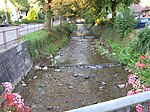Bundesautobahn 862
All pages needing cleanupFormer autobahns in GermanyInfobox road instances in GermanyInfobox road maps tracking categoryRoads in Baden-Württemberg

Bundesautobahn 862 (translates from German as Federal Motorway 862, short form Autobahn 862, abbreviated as BAB 862 or A 862) was an autobahn in Germany. Its purpose was to connect the French Autoroute 36 with the German Bundesautobahn 5 via a bridge over the Rhine. At 400 metres, the A 862 was Germany's shortest autobahn; it was later integrated as an onramp into the A 5.
Excerpt from the Wikipedia article Bundesautobahn 862 (License: CC BY-SA 3.0, Authors, Images).Bundesautobahn 862
Allée des Mauves, Paris Quartier de Charonne (Paris)
Geographical coordinates (GPS) Address Nearby Places Show on map
Geographical coordinates (GPS)
| Latitude | Longitude |
|---|---|
| N 47.775833333333 ° | E 7.5319444444444 ° |
Address
Allée des Mauves 8
75020 Paris, Quartier de Charonne (Paris)
Île-de-France, France
Open on Google Maps








